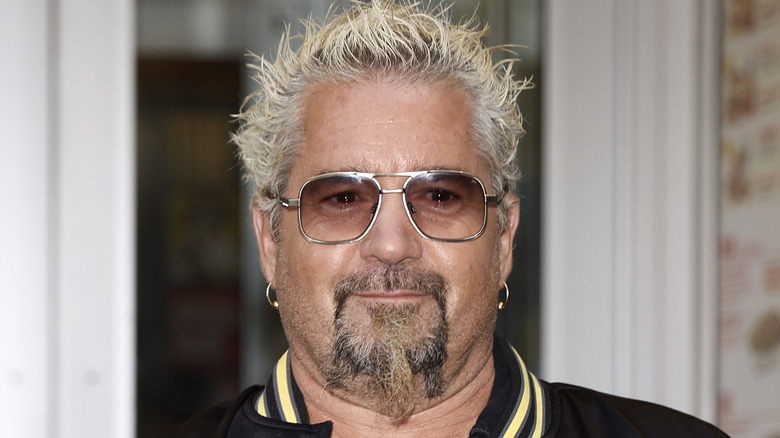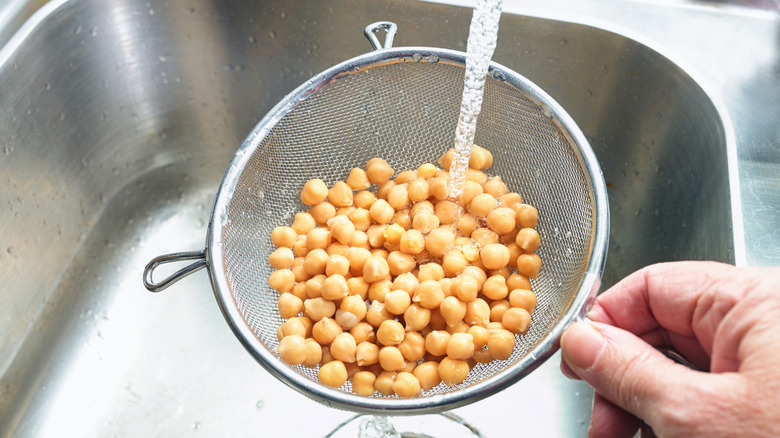The Textural Reason Guy Fieri Prefers Dried Beans Over Canned
When deciding whether to go with fresh or dried ingredients over the super easy, ready-to-go canned or prepped and powdered stuff, you can come to a bit of a conundrum. In certain desserts, canned peaches are preferred over fresh. And you can often make as fancy a meal with canned escargot (if prepared correctly) as you can with fresh snails. But where does the Mayor of Flavortown fall on the subject? There is certainly one prepared pantry ingredient Guy Fieri never goes without — powdered chicken stock. However, when it comes to canned beans, Fieri says it's best to avoid them and stick to the dried ones: They're just better, and it's all about the texture.
In a TikTok video via Food & Wine on the subject of dried beans, Fieri says, " ... For a lot of cultures, beans are the center of the plate. ... It is the super protein, and you're looking for texture. Texture is what we're all about. When a bean sits in liquid for so long ... it just becomes poached and soggy — granted creamy and delicious and still fortifying — ... But there's nothing like the texture of a dried bean." So, how do you get that perfect texture from dried beans to really let them shine? And when should you use canned beans instead of dried?
How to prep dried beans for perfect texture
Properly preparing dried beans is not exactly difficult; they just need plenty of time to soften up. But they'll end up with a nice semi-crunchy texture, more of a structural pop, and more flavor than canned. There is often a debate about whether you should pre-soak your beans or just throw them right on the stove. When soaked, they might be a bit easier to digest, and it will cut down the eventual cooking time. Soaking in a saltwater solution is ideal to soften the skins and imbue them with a bit of extra flavor. About eight hours is the minimum you should soak your beans, but a full 24 hours is completely fine.
Once they've had a sufficient soak, you should rinse and simmer them in fresh water — use enough to cover them by a couple of inches or so — for about 30 minutes. From here, you can season them however you care to. Certainly a bit of salt is a good idea, but you can add herbs, aromatics, or some chili flakes or cayenne. They'll need to cook another 30 minutes or up to a couple of hours. Skim the foam, and check your beans for flavor and texture as they cook. Also, make sure the beans are always covered in water; if they're not, add more. When you can smash a bean against the side of your pot with a fork, they're done and ready to be the star of the show, however you decide to use them.
How and when to use canned beans, and how to substitute dried for canned
If you want to save time, can you still use canned beans? Sure, they're great as a quick and easy side dish — you can just heat them up on the stove or in the microwave, add a bit of herbs and spices, and they're ready to go. They make a nice salad topper or protein add-on in a hot pasta, if you're okay with a bit of a creamier, softer consistency. Heck, even Guy Fieri prefers canned beans in certain recipes, like his black bean salad. They can be great cold with other, crunchier ingredients, like corn, onions, and celery.
Canned chickpeas and cannellini beans tend to be more believable stand-ins for dried beans because their texture holds up a bit better in the can. Conversely, for super velvety hummus, you may want to soften your beans even more. Boiling them with a dash of baking soda is the secret you need for super creamy canned chickpeas. However, if you're working with a recipe that calls for canned beans, and you'd still prefer the texture of your beautifully cooked dry beans, a pretty basic conversion is about ¾ cup of the dried version (before cooking) for a 15-ounce can. So, go with dried when you want the perfectly cooked bean, but remember that Guy Fieri himself uses canned beans from time to time.


